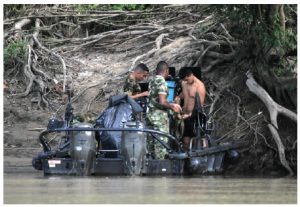
After many years of bad publicity, the news from Colombia in the international media is being framed in a much more positive light. At a time during which uncertainty and international crises abound, Colombia is, uncharacteristically, attracting good reviews. A strong economy, along with a dramatic reduction in the violence and insecurity that were present for decades, are some of the key ingredients contributing to the current status quo.
Finally, it seems, Colombia is doing all the right things. But, one big question remains unanswered: Will the latest peace negotiations with FARC (Revolutionary Armed Forces of Colombia), the 50-yearold guerrilla group, bear fruit? Being able to exchange the armed struggle for a battle of ideas is an essential component for Colombia to succeed in the near future.
At press time, the question is still open. But reason for optimism remains as the parties have never been closer to an agreement. After several failed talks in the ’80s and ’90s between the government and FARC, this time, it seems there is more than a credible chance.
The agreement’s main objective is to end armed conflict. Contrary to other failed processes, this time there are no territorial clearances and military operations by the government have not been suspended. President Juan Manuel Santos has said that if, and when, there is an agreement, it will be presented to the Colombian people, in the form of a referendum, for their approval.

Five-point agreement
Under the premise that “nothing is agreed until everything has been agreed,” the talks, officially launched in November 2012, have already resulted in agreement on three of the five main points under discussion.
The first is a rural land development policy, which provides for access to land and land use for peasants with no, or unsufficient land, a historic grievance of FARC’s, along with loans, technical assistance, irrigation and marketing support for crops. It includes a massive implementation plan, a new agricultural jurisdiction and an updating and upgrading of the national land registry (cadastre) and the rural real estate tax.
The second involves political participation for FARC. It facilitates the creation of new political parties and provides for special transitory electoral districts in the regions most affected by the conflict. The inhabitants of those regions will be able to elect, during a transitional phase, additional members to the House of Representatives. Measures to increase women’s participation in the electoral process and to promote a democratic culture of tolerance will be implemented.
The third agreed-upon point is titled, “a solution to the illicit drug problem.” On this point, FARC has specifically agreed to end any relationship with drugs. The agreement sets the basis for new, illicit crop substitution and alternative development programs. It includes a de-mining program through which FARC will provide information on mine locations.
Reparations and disarming
In 2014, the government and FARC began simultaneous discussions on the two remaining points on the agenda, in parallel working groups. The first is the rights of victims of the conflict, which includes reparation to victims and the elucidation of the truth behind so many deaths and disappearances. The second involves disarming FARC.
Additionally, the parties are also currently discussing how key aspects of the five sections will be implemented, verified and ratified.
Mr. Santos’ experience in government has prepared him well for this, his biggest challenge to date. Having served as trade minister, finance minister and defence minister under three different governments, he has witnessed the failure of several peace talks. This is why, as soon as he was sworn into office in 2010, and before the negotiations with FARC began, he submitted two bills to Congress that proved essential for the process.
A historic bill was passed in 2011, providing for land restitution and victim compensation with more than US $25 billion appropriated by the government to provide for reparations and the possibility of returning land to the many displaced victims.
Additionally, Mr. Santos sought and obtained a constitutional amendment that authorizes Congress, if presented with a peace agreement, to sanction a law providing for a “comprehensive transitional justice strategy.” This will allow the independent office of the attorney general to apply different judicial and extra-judicial measures to satisfy the rights of the victims to truth, justice and reparations, but also allowing for the reintegration of former combatants into civilian life.
In hindsight, the democratic debate and all of these legal and congressional reforms demonstrate Mr. Santos’ resolve and his planning capabilities to try to end a conflict that has lasted more than half a century.
Confronting human rights violations
As with every complex matter, the devil is in the details. Almost no one in Colombia is opposed to reaching peace with FARC. The debate centres around the legal treatment of those who have taken part in severe human rights violations during the armed conflict. The treatment such individuals receive under the application of transitional justice will depend on their willingness to recognize their responsibility, face their victims and actively participate in the truth and reparations mechanisms.
In Colombia, where we have to confront a legacy of massive human rights violations, the fight against impunity must acknowledge the limits of the ordinary criminal justice system. More than the number of prosecutions and years of imprisonment, the fight against impunity must focus on unveiling what actually happened and why; on acknowledging the victims and providing them with comprehensive and prompt reparations and on attributing the responsibility to those most responsible for international crimes.
Borrowing from successful peace agreements across the world, and observing the special characteristics of the Colombian conflict, it is evident that transitional justice is not an act of resignation or concession to those who committed crimes. Rather, it is an opportunity to face, once and for all, severe human rights violations and finally entrench the rule of law in the entire territory of Colombia.





